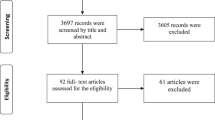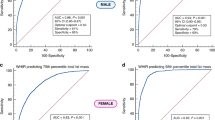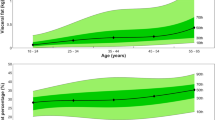Abstract
Objective:
To describe abdominal adipose tissue distribution in a large sample of contemporary British children; to determine the influence of gender, stage of maturation and body mass index (BMI) on abdominal adipose tissue distribution; and to compare the ability of BMI and waist circumference to predict abdominal adipose tissue.
Subjects and methods:
A total of 74 boys (mean age 13.4±0.4 years) and 96 girls (mean age 13.5±0.5 years) were selected from volunteer children enrolled in the Avon Longitudinal Study of Parents and Children (ALSPAC). Height, weight and waist circumference were measured and BMI calculated. Stage of sexual maturation was available for 113 children using a self-report questionnaire based on Tanner's criteria. Magnetic resonance imaging was used to assess subcutaneous abdominal adipose tissue (SAAT) and intra-abdominal adipose tissue (IAAT) volumes and patterning.
Results:
Boys had lower levels of IAAT (P=0.036) and SAAT (P=0.003) than girls. IAAT and SAAT were higher in overweight and obese boys and girls when compared with normal weight children (P<0.0001). This pattern was also reflected in waist circumference groups. Boys had higher IAAT/SAAT ratios than girls, indicating proportionately more adipose tissue deposited intra-abdominally (P=0.002). However, both boys and girls deposited less than 10% of their abdominal fat as internal adipose tissue. WC predicted 67.4% of the variance in IAAT (P<0.001), and BMI predicted 84.8% of the variance in SAAT (P<0.001). However, BMI as the best single predictor explained only 8.4% of the variance in the IAAT/SAAT ratio (P<0.001).
Conclusions:
At this age and stage of sexual maturation, the amount of IAAT remains relatively small. WC and BMI offer a feasible alternative to the MRI estimation of IAAT and SAAT, respectively, in a population-based sample of boys and girls.
This is a preview of subscription content, access via your institution
Access options
Subscribe to this journal
Receive 12 print issues and online access
$259.00 per year
only $21.58 per issue
Buy this article
- Purchase on Springer Link
- Instant access to full article PDF
Prices may be subject to local taxes which are calculated during checkout
Similar content being viewed by others
References
Anderson P, Chan J, Chan Y, Tomlinson B, Young R, Lee Z et al. Visceral fat and cardiovascular risk factors in Chinese NIDDM patients. Diabetes Care 1997; 20: 1854–1858.
Bjorntorp P . Abdominal fat distribution and disease: an overview of epidemiological data. Ann Med 1992; 24: 15–18.
De Simone M, Verrotti A, Iughetti L, Palumbo M, Farello G, Di Cesare E et al. Increased visceral adipose tissue is associated with increased circulating insulin and decreased sex hormone binding globulin levels in massively obese adolescent girls. J Endocrinol Invest 2001; 24: 438–444.
Kissebah AH . Intra-abdominal fat: is it a major factor in developing diabetes and coronary artery disease? Diabetes Res Clin Pract 1996; 30 (Suppl 1): S25–S30.
Lamarche B . Abdominal obesity and its metabolic complications: implications for the risk of ischaemic heart disease. Coron Artery Dis 1998; 9: 473–481.
Calle EE, Rodriguez C, Walker-Thurmond K, Thun MJ . Overweight, obesity, and mortality from cancer in a prospectively studied cohort of US adults. N Engl J Med 2003; 348: 1625–1638.
Carr DB, Utzschneider KM, Hull RL, Kodama K, Retzlaff BM, Brunzell JD et al. Intra-abdominal fat is a major determinant of the National Cholesterol Education Program Adult Treatment Panel III criteria for the metabolic syndrome. Diabetes 2004; 53: 2087–2094.
Hayashi T, Boyko EJ, Leonetti DL, McNeely MJ, Newell-Morris L, Kahn SE et al. Visceral adiposity is an independent predictor of incident hypertension in Japanese Americans. Ann Intern Med 2004; 140: 992–1000.
Kissebah AH, Vydelingum N, Murray R, Evans DJ, Hartz AJ, Kalkhoff RK et al. Relation of body fat distribution to metabolic complications of obesity. J Clin Endocrinol Metab 1982; 54: 254–260.
Livingston EH . Lower body subcutaneous fat accumulation and diabetes mellitus risk. Surg Obes Relat Dis 2006; 2: 362–368.
Miyazaki Y, Glass L, Triplitt C, Wajcberg E, Mandarino LJ, DeFronzo RA . Abdominal fat distribution and peripheral and hepatic insulin resistance in type 2 diabetes mellitus. Am J Physiol Endocrinol Metab 2002; 283: E1135–E1143.
Bjorntorp P . Regional patterns of fat distribution. Ann Intern Med 1985; 103: 994–995.
DeNino WF, Tchernof A, Dionne IJ, Toth MJ, Ades PA, Sites CK et al. Contribution of abdominal adiposity to age-related differences in insulin sensitivity and plasma lipids in healthy nonobese women. Diabetes Care 2001; 24: 925–932.
Frayn KN . Visceral fat and insulin resistance—causative or correlative? Br J Nutr 2000; 83 (Suppl 1): S71–S77.
Onat A, Avci GS, Barlan MM, Uyarel H, Uzunlar B, Sansoy V . Measures of abdominal obesity assessed for visceral adiposity and relation to coronary risk. Int J Obes 2004; 28: 1018–1025.
Smith SR, Lovejoy JC, Greenway F, Ryan D, deJonge L, de la Bretonne J et al. Contributions of total body fat, abdominal subcutaneous adipose tissue compartments, and visceral adipose tissue to the metabolic complications of obesity. Metabolism 2001; 50: 425–435.
Vega GL, Adams-Huet B, Peshock R, Willett D, Shah B, Grundy SM . Influence of body fat content and distribution on variation in metabolic risk. J Clin Endocrinol Metab 2006; 91: 4459–4466.
Wagenknecht LE, Langefeld CD, Scherzinger AL, Norris JM, Haffner SM, Saad MF et al. Insulin sensitivity, insulin secretion, and abdominal fat: the Insulin Resistance Atherosclerosis Study (IRAS) Family Study. Diabetes 2003; 52: 2490–2496.
Bacha F, Saad R, Gungor N, Janosky J, Arslanian SA . Obesity, regional fat distribution, and syndrome X in obese black versus white adolescents: race differential in diabetogenic and atherogenic risk factors. J Clin Endocrinol Metab 2003; 88: 2534–2540.
Brambilla P, Manzoni P, Agostini G, Beccaria L, Ruotolo G, Sironi S et al. Persisting obesity starting before puberty is associated with stable intraabdominal fat during adolescence. Int J Obes 1999; 23: 299–303.
Caprio S . Relationship between abdominal visceral fat and metabolic risk factors in obese adolescents. Am J Human Biol 1999; 11: 259–266.
Firek-Pedras M, Malecka-Tendera E, Klimek K, Zachurzok-Buczynska A . Influence of fat tissue distribution on metabolic complications in children and adolescents with simple obesity. Endokrynol Diabetol Chor Przemiany Materii Wieku Rozw 2006; 12: 19–24.
Hirschler V, Aranda C, Calcagno Mde L, Maccalini G, Jadzinsky M . Can waist circumference identify children with the metabolic syndrome? Arch Pediatr Adolesc Med 2005; 159: 740–744.
Goran MI, Gower BA, Treuth M, Nagy TR . Prediction of intra-abdominal and subcutaneous abdominal adipose tissue in healthy pre-pubertal children. Int J Obes 1998; 22: 549–558.
Owens S, Litaker M, Allison J, Riggs S, Ferguson M, Gutin B . Prediction of visceral adipose tissue from simple anthropometric measurements in youths with obesity. Obes Res 1999; 7: 16–22.
Hoffer FA . Magnetic resonance imaging of abdominal masses in the pediatric patient. Semin Ultrasound CT MR 2005; 26: 212–223.
Brambilla P, Bedogni G, Moreno LA, Goran MI, Gutin B, Fox KR et al. Crossvalidation of anthropometry against magnetic resonance imaging for the assessment of visceral and subcutaneous adipose tissue in children. Int J Obes 2006; 30: 23–30.
Shaibi GQ, Cruz ML, Weigensberg MJ, Toledo-Corral CM, Lane CJ, Kelly LA et al. Adiponectin independently predicts metabolic syndrome in overweight Latino youth. J Clin Endocrinol Metab 2007; 92: 1809–1813.
Davis JN, Weigensberg MJ, Shaibi GQ, Crespo NC, Kelly LA, Lane CJ et al. Influence of breastfeeding on obesity and type 2 diabetes risk factors in Latino youth with a family history of type 2 diabetes. Diabetes Care 2007; 30: 784–789.
Fox KR, Peters DM, Armstrong N, Sharpe P, Bell M . Abdominal fat deposition in 11-year-old children. Int J Obes 1993; 17: 11–16.
Fox KR, Peters DM, Sharpe P, Bell ME . Assessment of abdominal fat development in young adolescents using magnetic resonance imaging. Int J Obes 2000; 24: 1653–1659.
Golding J, Pembrey M, Jones R . ALSPAC—the Avon Longitudinal Study of Parents and Children. I. Study methodology. Paediatr Perinat Epidemiol 2001; 15: 74–87.
Lohman TG, Roche AF, Martorell R . Anthropometric Standardization Reference Manual 1988. Human Kinetics: Champaign, IL.
Cole TJ, Freeman JV, Preece MA . Body mass index reference curves for the UK, 1990. Arch Dis Child 1995; 73: 25–29.
Chu N-F, Wang D-J, Shieh S-M . Obesity, leptin and blood pressure among children in Taiwan: the Taipei children's heart study. Am J Hypertens 2001; 14: 135–140.
McCarthy HD, Jarrett KV, Crawley HF . The development of waist circumference percentiles in British children aged 5.0–16.9 y. Eur J Clin Nutr 2001; 55: 902–907.
Duke PM, Litt IF, Gross RT . Adolescents’ self-assessment of sexual maturation. Pediatrics 1980; 66: 918–920.
Tanner JM, Whitehouse RH . Clinical longitudinal standards for height, weight, height velocity, weight velocity and stages of puberty. Arch Dis Child 1976; 51: 170–179.
Bo W, Wolfman N, Krueger W, Carr J, Bowden R, Meschan I . Basic Atlas of Sectional Anatomy 4th Edition – with Correlated Imaging 2006: Saunders, ISBN: 1416001212.
Gray DS, Fujioka K, Colletti PM, Kim H, Devine W, Cuyegkeng T et al. Magnetic-resonance imaging used for determining fat distribution in obesity and diabetes. Am J Clin Nutr 1991; 54: 623–627.
Goran MI, Gower BA . Relation between visceral fat and disease risk in children and adolescents. Am J Clin Nutr 1999; 70: 149S–156S.
Goran MI, Nagy TR, Treuth MS, Trowbridge C, Dezenberg C, McGloin A et al. Visceral fat in white and African American prepubertal children. Am J Clin Nutr 1997; 65: 1703–1708.
Shrout PE, Fleiss JL . Intraclass correlations: uses in assessing rater reliability. Psychological Bulletin 1979; 86: 420–428.
Landis JR, Koch GG . The measurement of observer agreement for categorical data. Biometrics 1977; 33: 159–174.
Gravetter FJ, Wallnau LB . Statistics for the Behavioral Sciences 5th edn. 2000. Wadsworth: Belmont, CA.
Fox J . Regression Diagnostics Quantitative Applications in the Social Sciences Series No. 79 1991. Sage Publications: Thousand Oaks, CA.
Guo S, Chumlea W . Statistical methods for the development and testing of predictive equations, In: Roche AF, Heymsfield SB, Lohman TG (eds). Human Body Composition. Human Kinetics: Champaign, IL, 1996, pp 191–202.
Cole TJ, Bellizzi MC, Flegal KM, Dietz WH . Establishing a standard definition for child overweight and obesity worldwide: International survey. BMJ 2000; 320: 1240–1246.
Cohen JW . Statistical power analysis for the behavioral sciences 2nd edn. 1988. Lawrence Erlbaum Associates: Hillsdale, NJ.
Owens S, Gutin B, Barbeau P, Litaker M, Allison J, Humphries M et al. Visceral adipose tissue and markers of the insulin resistance syndrome in obese black and white teenagers. Obes Res 2000; 8: 287–293.
Caprio S, Hyman L, McCarthy S, Lange R, Bronson M, Tamborlane W . Fat distribution and cardiovascular risk factors in obese adolescent girls: importance of the intra-abdominal fat depot. Am J Clin Nutr 1996; 64: 12–17.
Saelens BE, Seeley RJ, van Schaick K, Donnelly LF, O'Brien K J . Visceral abdominal fat is correlated with whole-body fat and physical activity among 8-y-old children at risk of obesity. Am J Clin Nutr 2007; 85: 46–53.
Seidell JC, Oosterlee A, Deurenberg P, Hautvast JG, Ruijs JH . Abdominal fat depots measured with computed tomography: effects of degree of obesity, sex, and age. Eur J Clin Nutr 1988; 42: 805–815.
de Ridder CM, de Boer RW, Seidell JC, Nieuwenhoff CM, Jeneson JA, Bakker CJ et al. Body fat distribution in pubertal girls quantified by magnetic resonance imaging. Int J Obes 1992; 16: 443–449.
Acknowledgements
We are extremely grateful to all the families who took part in this study, the midwives for their help in recruiting them and the whole ALSPAC team, which includes interviewers, computer and laboratory technicians, clerical workers, research scientists, volunteers, managers, receptionists and nurses. Additionally, our gratitude is extended to the management and radiography team at the Somerset MRI Centre for assisting with and supporting this research. The UK Medical Research Council, the Wellcome Trust and the University of Bristol provide core support for ALSPAC. This publication is the work of the authors and Professors KR Fox and A Ness will serve as guarantors for the contents of this paper. This research was specifically funded by the Wellcome Trust.
Author information
Authors and Affiliations
Corresponding author
Rights and permissions
About this article
Cite this article
Benfield, L., Fox, K., Peters, D. et al. Magnetic resonance imaging of abdominal adiposity in a large cohort of British children. Int J Obes 32, 91–99 (2008). https://doi.org/10.1038/sj.ijo.0803780
Received:
Revised:
Accepted:
Published:
Issue Date:
DOI: https://doi.org/10.1038/sj.ijo.0803780
Keywords
This article is cited by
-
Pediatric body composition based on automatic segmentation of computed tomography scans: a pilot study
Pediatric Radiology (2023)
-
Effectiveness of a body shape index in predicting pediatric high blood pressure
Pediatric Research (2022)
-
Effect of High-Intensity Interval Training on Fitness, Fat Mass and Cardiometabolic Biomarkers in Children with Obesity: A Randomised Controlled Trial
Sports Medicine (2018)
-
Association between individual fat depots and cardio-metabolic traits in normal- and overweight children, adolescents and adults
Nutrition & Diabetes (2017)
-
Anthropometry, DXA, and leptin reflect subcutaneous but not visceral abdominal adipose tissue on MRI in 197 healthy adolescents
Pediatric Research (2017)



